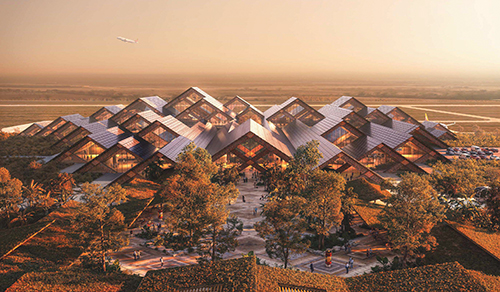The future of the entire Gelephu Mindfulness City (GMC) project depends on the Gelephu International Airport (GIA) getting the two key routes through India for landing and takeoff.
Bhutan formally placed a request for the two routes, Igay and Taray in the east and west, to directly fly out and in from the GIA in October 2024.
Discussions have been going on between both sides since then, and there is optimism on both sides that this will eventually come through though it may take some time.
The latest development on this front is that both the countries are in the process of jointly drafting an important overall Memorandum of Understanding (MoU) that will then be the template for moving forward on the GIA routes and more.
FIR
The most important component of the MOU currently being discussed by both countries is on the Flight Information Region (FIR) over Bhutan.
While the airspace above Bhutan is the country’s sovereign airspace, given the comparatively late entry of civil aviation to Bhutan and the limited capacity of the past, Bhutan is yet to list the airspace above Bhutan under the FIR of Bhutan with the International Civil Aviation Organization (ICAO).
FIR is a clearly defined block of airspace above a country for which the country is responsible to provide Air Traffic Services like flight information services, alerting services and general airspace management.
The Indian side has indicated that both countries need to resolve the FIR issue first in the MOU before proceeding onto the GIA.
For Bhutan itself, while a FIR was always important and a part of the natural evolution of its aviation sector, it assumed more importance in the last few years with GMC and GIA as a means to attract potential investors and even airlines as the absence of a Bhutan controlled FIR would be a potential barrier.
Both sides are negotiating the MOU and the first step in that is both sides draft their own points they want in the MOU and send it to each other.
The Bhutanese side is likely to seek help from the Government of India for Bhutan’s aim to have its own FIR over Bhutan by applying with the ICAO and also putting in the remaining infrastructure and manpower required for such a FIR.
India itself has four FIRs in Delhi, Chennai, Kolkata and Mumbai, and so has a rich experience and capacity in this field that Bhutan can look to for help in setting up its own FIR.
The idea of a Bhutan FIR is simple, in that the sovereign airspace over Bhutan should be controlled and managed by Bhutan as it now has the technical capacity to do so, and also the need to do so. Bhutan has not handed over this FIR right to anyone till date.
Two Routes and Letter of Agreement
In line with its formal request in October 2024 Bhutan is also likely to ask for the two routes of Igay and Taray in the MOU for the GIA which is the key request from Bhutan.
Linked to this is the requirement to get a Terminal Control Area on the Indian side, around 20 km deep, when planes maneuver to land or take off from the GIA, whereby the Bhutanese Air Traffic Service in the GIA can guide and manage the planes in the air.
Bhutan will also aim through the MOU to get a ‘Letter of Agreement’ signed between the two countries which will formalize the cross-border air traffic operations that is already happening in the air, but there is no agreement yet. For example, when a plane flying from Paro to Bangkok is in the air, it will inform that Kolkata FIR that it is about to transition into Indian airspace under Kolkata FIR
The ‘Letter of Agreement’ issue that is likely to be there in the MOU is a larger issue that goes even beyond the GIA and FIR, as the lack of such a letter was one of the reasons Bhutan was red-flagged by the ICAO in 2018 and till this day Bhutan has not been able to resolve the issue.
The ICAO in August 2018 conducted an ICAO coordinated validation mission (ICVM) in Bhutan to verify the progress made by Bhutan in resolving the deficiencies identified during the 2006 initial audit.
As a result of the ICVM the ICAO red-flagged Bhutan with ‘Significant Safety Concern,’ (SSC) due to three issues.
Issue one was the ATS and the Metrological Services in the Paro International Airport being under the Indian Airforce as it is supposed to be under the control of civil aviation authorities of Bhutan.
To resolve this, there were bilateral meetings between Bhutanese and Indian officials and control was handed over to the Department of Air Transport under Bhutan. Only one or two Indian Airforce personnel would be there at the Control Tower for Indian VVIP and military flights (like helicopters.) The former government had said this issue was resolved during the monthly press meet in 2019 in response to a question from the media.
The second issue was on the lack of clarity of information in the Aeronautical Information Publication (AIP) on airspace designation, classification and type of ATS provided at Paro and the rest of Bhutan.
To resolve this, the AIP was thoroughly reviewed and amendments were made to provide precise and clear information as required. As required for Air Traffic Control services, the Paro International Airport established an aerodrome control zone (CTR) and airspace within it was classified and the one above it too.
This left the only pending issue of the ‘Letter of Agreement’ required between the Paro ATS under the DoAT and the Kolkata Area Control Center under the Airports Authority of India (AAI) regarding the coordination of air traffic flow between their respective areas of responsibility.
The ICAO Combined Action Team mission to Bhutan in March 2020 again pointed to the lack of this Letter and again flagged the issue.
The DoAT was in discussions with the AAI since January 2021 but the contents of the letter could not be agreed upon between both sides. The matter was followed up subsequently again including in October 2023 and even recently but there has been no movement on this front.
This leaves Bhutan with the ‘Significant Safety Concern’ tagging of the ICAO which is not suitable at a time when Bhutan is going for GMC and trying to operationalize the GIA.
It is hoped that the MOU can help address this issue.
Once the MOU is done it is also hoped that Bhutan can secure Fifth Freedom Rights while flying via India (Delhi) to destinations like Dubai so that it can pick up some local passengers to make the flight route viable.
For the Indian side, the key issue seems to be the FIR over Bhutan and how it is done, and for the Bhutanese side the FIR is important both in the context of Bhutan’s ATS control over its sovereign skies, and now more so with the GMC and GIA.
Once there is an understanding on the FIR then the GMC and GIA’s two air routes and the letter of agreement are likely to proceed more smoothly.
While things may have not moved as much in the past, GMC and GIA have become the game changers.
Positive Development
During the recent visit of Prime Minister Narendra Modi, the Government of India conveyed its full support for the realisation of His Majesty’s vision for GMC, and PM Modi even said that GMC fits into India’s ‘Act East Policy’.
There is no doubt that there is strong support in New Delhi for GMC and goodwill on both sides, and it is hoped that this political support and goodwill can lead to a fruitful outcome with the MOU and the subsequent agreements and details.
Meanwhile, Druk Air will start flights between GIA and Kolkata from 8th December 2025 onwards with two flights per week. The plane will be an ATR and the flight is expected to take more than an hour.
The flight will use the existing two air routes of Subsu and Bogo over India, but that is actually for planes flying from Paro and so the ATR will have to deviate towards Paro meaning additional time and fuel costs until the two additional routes are given.
A National Project
The GIA construction started on 8th July 2025 led by His Majesty The King, Her Majesty The Gyaltsuen, Their Royal Highnesses, members of the Royal Family, the Prime Minister, government ministers, officials and many members of the public.
His Majesty has worked on the site time and again leading thousands of volunteers from all walks of life.
The GMC Nation Building Bond raised Nu 3.3 billion from 35,000 Bhutanese, and the GMC Deposit raised millions of dollars from thousands of Bhutanese abroad all aimed at funding the GIA.
The GIA will be the first and most important infrastructure project of the GMC.
The airport will span 4 square kilometres across the Paitha River. Key features include a 3,000-metre CAT I Code 4E runway capable of handling Airbus A321 and Boeing 737 aircraft at the onset, and wide-body aircraft in the longer term.
It will have capacity for 1.3 million annual passengers initially, expandable to 5.5 million and beyond as required. The terminal design draws from Bhutan’s four forest ecosystems: evergreen oak, cool broadleaf, warm broadleaf, and subtropical. It will incorporate traditional craftsmanship, landscape zones with native flora, and future connections to Gelephu Mindfulness City developments.
The state-of-the-art airport will be built with ecological considerations. A box culvert system will maintain the Paitha River’s natural flow beneath the runway, terminal roofs will be fitted with photovoltaic panels, and the design will incorporate natural airflow and shading to optimise energy use. Locally sourced materials such as glulam (glue laminated) timber will be used.
Besides being a vital link to the world, the airport will provide employment during construction and operations, as well as training programs for Bhutanese workers, and cargo capacity to support exports.
The GIA project is slated to be complete by December 2029.
 The Bhutanese Leading the way.
The Bhutanese Leading the way.




